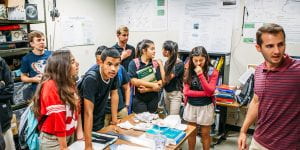Overview
USC STEM faculty in partnership with USC students build an innovative curriculum that is aligned with K-12 curriculum standards. The new curriculum also aims at broadening the knowledge of K-12 teachers in engineering and computer science. USC faculty combine various cutting-edge research performed in their labs into the K-12 curriculum. Students get hands-on experience working on the latest technologies, inspiring interest and enhancing knowledge in STEM programs.
This project builds upon two NSF-funded projects i.e Body Engineering in Los Angeles and Research Experience for Teachers. Seven or more USC Viterbi undergraduate and graduate students co-teach in grades 6-12 for 32 weeks per year which is highly scalable. Coordinator and lead faculty members work with USC faculty, USC students, and teachers to meet the student’s needs. Various resources such as Websites, videos, multimedia, and materials are created and used to educate, promote, scale and fundraise.
Program Goals
- Improving the engineering education and workforce pathways:
- Inspiring interest and enhancing knowledge and skills in STEM among diverse middle and high school students by supporting and improving their STEM curricula by bringing in experts to introduce and support cutting-edge research in STEM classes.
- Enhancing K-12 curricula and training teachers in STEM:
- Supporting K-12 teachers by enhancing their existing curricula and broadening their engineering and computer science knowledge. Developing and implementing new, innovative curricula aligned with K-12 standards to promote enthusiasm and STEM learning.
- Inspiring the next generation of teachers and enriching the undergraduate/graduate experience:
- Preparing USC Viterbi students to become STEM leaders by improving their communication, leadership, and collaboration skills through training and K-12 teaching/mentoring experience. Training USC students in innovative teaching techniques and exposing them to community service.
Intended Outcomes
- Flexible and new STEM curriculum for grades 6-12 that is highly innovative and easily adaptable that can serve as models for future courses.
- Multiple learning resources such as power-points, lesson plans, assignments, etc that can be shared and adapted.
- Estimated to have over 10,000 middle school and high school students learn cutting-edge STEM concepts and prepare for STEM pathways.
- Introduction of cutting-edge STEM research into grades 6-12 STEM pedagogy to keep students informed of the latest trends and developments in STEM.
- A new and highly scalable teaching and learning program at USC.
Key Takeaways
- Each USC student/teacher dyad (or triad) teaches approximately 90 grades 6-12 students per day.
- With seven USC students + teachers teaching roughly 1260 grades 6-12 students are taught each week.
- A total of 3,780 students from grades 6-12 are empowered with the latest STEM topics each year.
Current curriculum
Autonomous Driving
Introducing Robotics to K-12
Through this unit of study, high school students are introduced to cutting-edge STEM robotics topics such as planning, perception, and sensors. Students get to participate and perform hands-on projects related to object detection and shortest-path decision algorithms.
Serious Games
Introduction to programming through games
In this unit of study, high school and middle school students work in groups to build serious games. Through this exercise, students are also introduced to several programming concepts and learn to build a completely playable game using Microsoft MakeCode.
Data Science
Introduction to Health-Relevant Data Science
In this unit of study, students learn how to analyze data from health sciences. Students learn to observe and understand various principles of Data Science that enable key insights in the health industry, they build simple models such as Linear Regression while also learning ethical principles behind handling sensitive data.
Socially Assistive Robots
Introduction to Socially Assistive Robots
In this unit of study, students learn how to analyze data from health sciences. Students learn to observe and understand various principles of Data Science that enable key insights in the health industry, they build simple models such as Linear Regression while also learning ethical principles behind handling sensitive data.
Virtual Reality & Augmented Reality
Introduction to VR/AR
In this immersive VR/AR unit, high school students are introduced to topics like 3D modeling, coding effects, and VR headset tech. Students participate in hands-on projects like designing basic VR environments, building AR coloring book apps, and taking virtual field trips with pre-made simulations. The unit aims to build skills in innovation and problem-solving.
Assistive Technology & Artificial Intelligence
Introduction to Assistive Technology using AI
In this assistive tech unit, students are introduced to AI applications that aid people with disabilities. Through hands-on projects, students train machine learning models to recognize images for the visually impaired, build voice command apps, and program robots to help users with limited mobility. The course teaches high schoolers programming skills while promoting design thinking and empathy.
Biomedical Devices
Interdisciplinary introduction to Biomedical devices
This is another interdisciplinary STEM unit of study where students are introduced to various concepts from multiple disciplines such as mechanical and biomedical fields. Students work in groups to study how different concepts across disciplines come together to solve major problems in the health-tech industry.
If you like what we are doing and would like to contribute, please donate!
Related Stories

USC Viterbi to Launch New Program to Bring Engineering Education to Local Schools
Gallery









